For the 2025 school year, there is 1 public preschool serving 377 students in Meridian CUSD 223 School District.
Public Preschools in Meridian CUSD 223 School District have a diversity score of 0.33, which is less than the Illinois public preschool average of 0.70.
Minority enrollment is 19% of the student body (majority Hispanic), which is less than the Illinois public preschool average of 58% (majority Hispanic).
Overview
This School District
This State (IL)
# Schools
4 Schools
1,387 Schools
# Students
1,495 Students
512,005 Students
# Teachers
103 Teachers
38,167 Teachers
Student : Teacher Ratio
15:1
15:1
District Rank
Meridian CUSD 223 School District, which is ranked within the top 50% of all 844 school districts in Illinois (based off of combined math and reading proficiency testing data) for the 2020-2021 school year.
The school district's graduation rate of 85-89% has decreased from 90-94% over five school years.
Overall District Rank
#304 out of 852 school districts
(Top 50%)
(Top 50%)
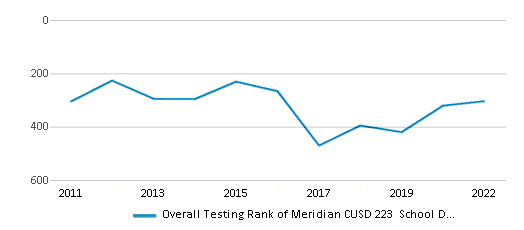
Math Test Scores (% Proficient)
(20-21)26%
28%
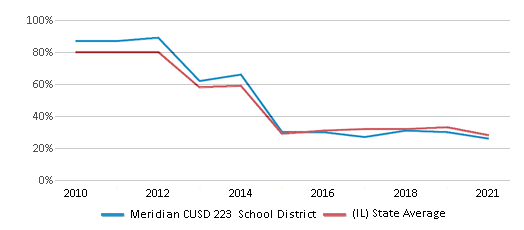
Reading/Language Arts Test Scores (% Proficient)
35%
30%
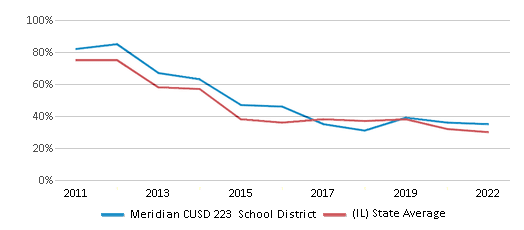
Science Test Scores (% Proficient)
55%
50%
Graduation Rate
85-89%
87%
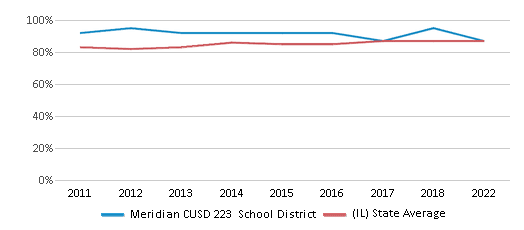
Students by Ethnicity:
Diversity Score
0.32
0.70
# American Indian Students
n/a
1,218 Students
% American Indian Students
n/a
n/a
# Asian Students
6 Students
20,502 Students
% Asian Students
n/a
4%
# Hispanic Students
201 Students
162,757 Students
% Hispanic Students
13%
32%
# Black Students
10 Students
94,002 Students
% Black Students
1%
18%
# White Students
1,221 Students
213,555 Students
% White Students
82%
42%
# Hawaiian Students
n/a
447 Students
% Hawaiian Students
n/a
n/a
# Two or more races Students
57 Students
19,465 Students
% of Two or more races Students
4%
4%
Students by Grade:
# Students in PK Grade:
56
76,065
# Students in K Grade:
99
71,052
# Students in 1st Grade:
115
68,700
# Students in 2nd Grade:
107
66,332
# Students in 3rd Grade:
103
56,657
# Students in 4th Grade:
110
53,643
# Students in 5th Grade:
95
46,874
# Students in 6th Grade:
123
28,049
# Students in 7th Grade:
111
22,127
# Students in 8th Grade:
104
22,424
# Students in 9th Grade:
101
40
# Students in 10th Grade:
129
12
# Students in 11th Grade:
109
12
# Students in 12th Grade:
133
18
# Ungraded Students:
-
-
District Revenue and Spending
The revenue/student of $20,755 in this school district is less than the state median of $21,990. The school district revenue/student has stayed relatively flat over four school years.
The school district's spending/student of $17,061 is less than the state median of $21,244. The school district spending/student has stayed relatively flat over four school years.
Total Revenue
$31 MM
$41,381 MM
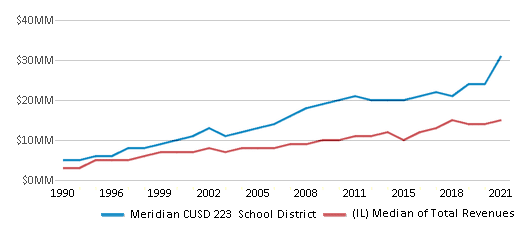
Spending
$26 MM
$39,976 MM
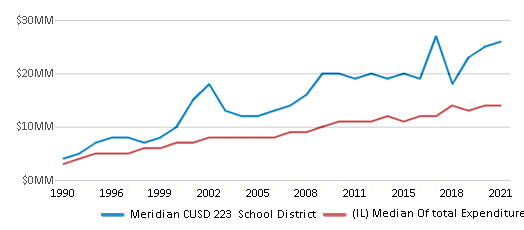
Revenue / Student
$20,755
$21,990
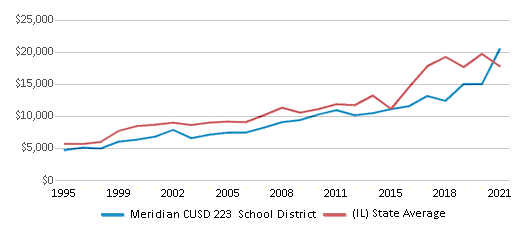
Spending / Student
$17,061
$21,244
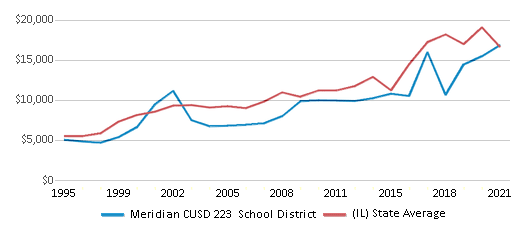
Best Meridian CUSD 223 School District Public Preschools (2025)
School
(Math and Reading Proficiency)
(Math and Reading Proficiency)
Location
Grades
Students
Rank: n/an/a
410 S Hickory St
Stillman Valley, IL 61084
(815) 645-2230
Stillman Valley, IL 61084
(815) 645-2230
Grades: PK-2
| 377 students
Recent Articles

Sexual Harassment at Age 6: The Tale of a First Grade Suspension
A six-year old in Aurora, Colorado, was suspended after singing an LMFAO song to a little girl in his class and reportedly “shaking his booty.” We look at the case and the sexual harassment problem in public schools today.

How Scaffolding Could Change the Way Your Child Learns
This article explores the concept of instructional scaffolding, a teaching method that enhances learning by breaking down complex tasks into manageable parts. It highlights how scaffolding supports students in developing critical thinking skills and becoming more independent learners. The article discusses the benefits of scaffolding, including improved engagement and reduced anxiety, and provides strategies for its implementation across various educational levels.

February 05, 2025
Understanding the U.S. Department of Education: Structure, Impact, and EvolutionWe explore how the Department of Education shapes American education, from its cabinet-level leadership to its impact on millions of students, written for general audiences seeking clarity on this vital institution.





